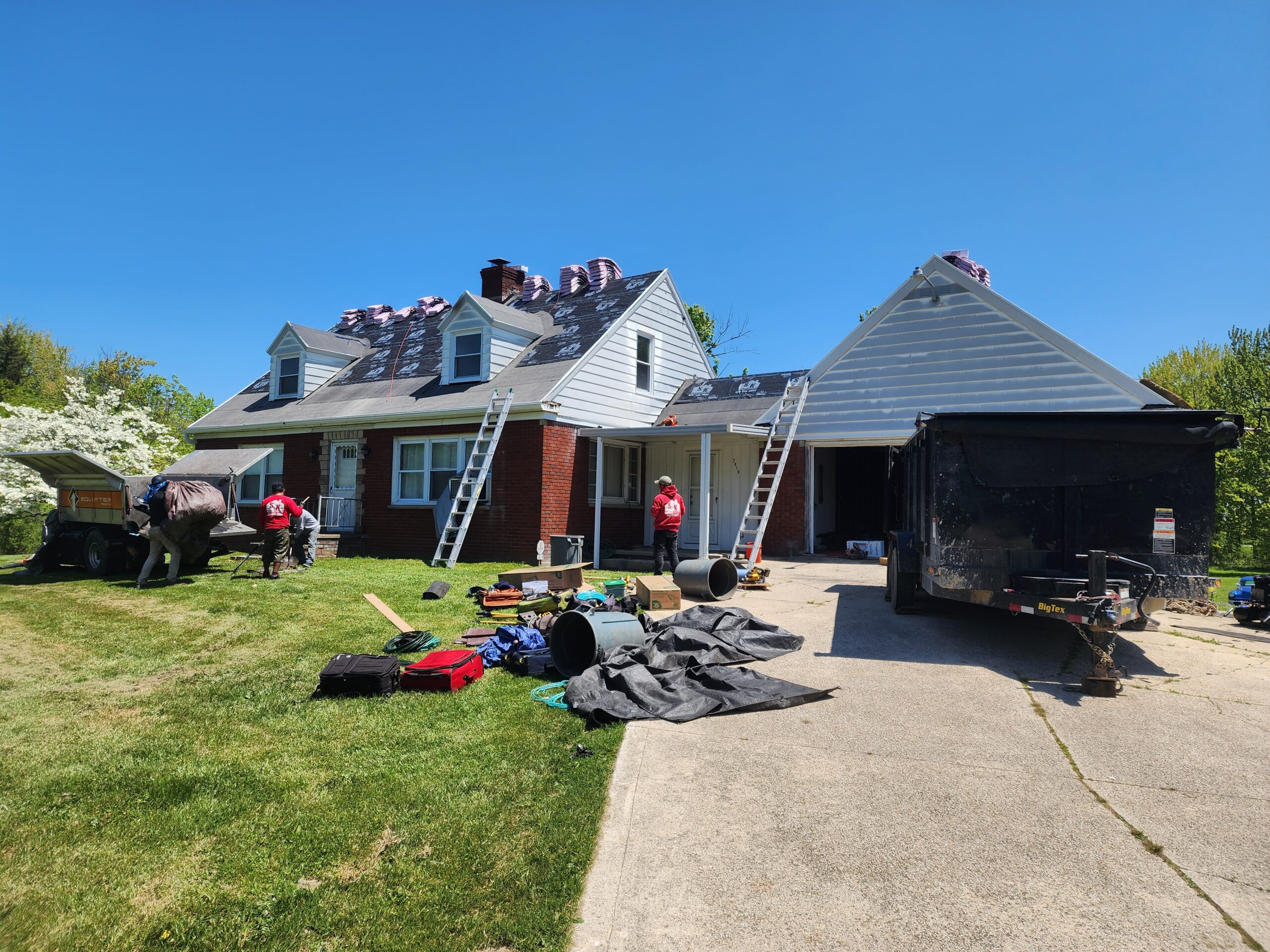Does a New Roof Increase Your Home’s Value?
When it comes to improving the value of your home, one of the most effective and essential investments you can make is installing a new roof. A roof is more than just a protective layer over your home; it plays a crucial role in the overall aesthetics, energy efficiency, and long-term durability of your property. In this blog post, we’ll dive into the reasons why a new roof can increase your home’s value, the financial benefits, and how it can make a difference when selling your property.
How Much Does a New Roof Increase Your Home’s Value?
While the precise amount that a new roof can increase your home’s value depends on a variety of factors—such as the current state of your roof, the type of roofing material you choose, the home’s location, and the market conditions—a new roof can typically add anywhere from 5% to 15% to the overall value of your home. This is significant, especially if you are considering selling your home or refinancing.
The increase in value is not only tied to the aesthetic improvement but also to the functionality and energy efficiency improvements that come with a new roof. A new roof can make your property stand out to potential buyers, reduce their maintenance worries, and provide energy-saving benefits that are attractive in today’s market.
Let’s break down the three key ways a new roof can increase your home’s value.
1. A New Roof Improves Your Home’s Curb Appeal
One of the first things potential buyers notice when they drive by or visit your home is its curb appeal. The roof is one of the most prominent features of the exterior of your home, and an old or damaged roof can make your house look rundown, neglected, and less inviting. On the other hand, a new roof can significantly enhance the look of your home and make it stand out in a positive way.
A roof replacement gives your house a fresh, clean, and modern look, which can immediately boost its attractiveness. Whether you choose traditional asphalt shingles, a luxurious slate roof, or a modern metal roof, a new roof can dramatically elevate the overall appearance of your property. This is especially important if your roof is nearing the end of its life cycle, has visible damage, or has aged out of style.
Curb appeal is crucial in a competitive real estate market, and a new roof can be the deciding factor that attracts buyers to your home. It signals to them that the house has been well-maintained and that they won’t need to worry about any immediate repairs or replacements after purchasing the property.
Furthermore, a new roof can create an appealing contrast with the rest of your home’s exterior features, such as the siding, windows, and landscaping. When everything works together harmoniously, the value of the property is elevated—not just in terms of its physical appearance, but also in terms of perceived value.
2. A New Roof Decreases Your Home’s Energy Bills
Energy efficiency is one of the top priorities for homeowners today. With rising energy costs and a growing concern for sustainability, homebuyers are increasingly interested in properties that offer energy-saving features. A new roof can be a game-changer when it comes to reducing your energy bills.
When a roof is old, damaged, or poorly insulated, it can lead to energy loss and higher heating and cooling costs. Gaps, leaks, and cracks in the roofing material allow air to escape, meaning your HVAC system must work harder to maintain a comfortable temperature inside your home. As a result, your monthly energy bills can skyrocket.
A new roof, on the other hand, is likely to have better insulation and reflectivity, depending on the materials used. For instance, many modern roofing materials, such as reflective shingles or metal roofing, are designed to reflect sunlight and prevent heat from entering the home. This reduces the need for air conditioning during hot summer months, helping you save on cooling costs.
In colder climates, a new roof can provide better insulation, keeping the warm air inside during the winter months and lowering your heating expenses. If your roof is installed with energy-efficient materials and modern techniques, you can expect reduced energy bills, which can be a strong selling point when it comes time to put your home on the market.
Homebuyers are likely to appreciate the long-term savings a new roof offers in terms of energy efficiency. This is particularly true in homes with older roofs, where energy inefficiency might be a significant concern. With more buyers looking for homes with green and energy-efficient features, a new roof can increase your home’s market value by making it more attractive to environmentally conscious buyers.
3. You’ll Avoid Spending More in the Long Run on Continuous Repairs
If your roof is aging, damaged, or in poor condition, you may be facing constant repairs, leaks, and potential water damage to your home’s interior. While patching up a roof or performing temporary repairs may seem like a short-term solution, it’s only a matter of time before you’re forced to spend more on repairs or even a full roof replacement.
One of the most significant benefits of installing a new roof is that it allows you to avoid these ongoing repair costs. Roofs typically last between 20 to 30 years, depending on the material and the local climate, so investing in a new roof can save you money in the long run. By replacing your roof, you’re essentially preventing the need for constant maintenance, and this is something both homeowners and potential buyers will appreciate.
Water damage from leaks can cause significant harm to your home’s structure, leading to expensive repairs and potential mold growth. The cost of repairing water-damaged ceilings, walls, and insulation can add up quickly, so it’s far more cost-effective to invest in a new roof to avoid such issues in the future.
For prospective buyers, a new roof represents peace of mind. They won’t have to worry about spending large sums of money on roof repairs or dealing with the stress of frequent leaks. This reliability and assurance of a sound roof can make your home more appealing compared to others with older, deteriorating roofs.
The ROI on a New Roof
The return on investment (ROI) for a new roof can vary based on your location, the roofing materials used, and the overall condition of your home. However, studies have shown that homeowners can recoup a significant portion of the cost of a new roof when they sell their property.
In general, you can expect to recover anywhere from 60% to 80% of the cost of a new roof through the increase in home value. For instance, if a roof replacement costs around $10,000, you might see an increase in the resale value of your home by $6,000 to $8,000. This ROI can be even higher in certain markets where the demand for well-maintained, energy-efficient homes is strong.
The exact ROI will depend on how much you invest in the roof, the materials you choose, and the market conditions in your area. However, the benefits of installing a new roof extend beyond resale value. Even if you’re not planning to sell right away, the improvements to curb appeal, energy efficiency, and long-term durability will pay off for years to come.
Choosing the Right Roofing Material
When investing in a new roof, it’s essential to select the right materials to maximize the return on investment. The roofing material you choose can impact the value it adds to your home. Here are some of the most popular roofing materials and their potential benefits:
- Asphalt Shingles: Affordable, durable, and versatile, asphalt shingles are a popular choice for homeowners. They come in various colors and styles and offer a good balance of cost and performance.
- Metal Roofing: Known for its durability and energy efficiency, metal roofing is becoming increasingly popular. It’s more expensive than asphalt shingles, but it offers a long lifespan and excellent protection against the elements.
- Wood Shingles: Wood roofs offer a natural, classic look and can increase the aesthetic value of your home. However, they require more maintenance than other options and are more susceptible to fire and pests.
- Slate Roofing: Slate is one of the most durable and attractive roofing materials available. It’s long-lasting, fire-resistant, and eco-friendly, but it’s also one of the most expensive options.
- Tile Roofing: Common in Mediterranean and Spanish-style homes, tile roofs are durable and offer a unique aesthetic. They are highly resistant to heat and moisture but can be more expensive than asphalt shingles.
Each roofing material has its pros and cons, so it’s important to choose one that fits your budget, style preferences, and long-term goals for your home.
Conclusion
A new roof is not just a functional upgrade to your home—it’s a valuable investment that can increase your property’s value, improve curb appeal, and enhance energy efficiency. By replacing an old roof, you’ll not only avoid costly repairs and maintenance in the future but also provide peace of mind to potential buyers, making your home more attractive in a competitive market.
Whether you’re planning to sell your home soon or simply want to increase its long-term value, investing in a new roof is one of the smartest decisions you can make. Not only will it improve the aesthetic appeal of your home, but it will also provide you with significant savings on energy bills and reduce the need for ongoing repairs.
In the end, a new roof is an investment that will pay off in more ways than one—enhancing your home’s value, livability, and longevity. So, if you’re considering a roof replacement, don’t hesitate to reach out to a trusted roofing contractor and take the first step toward protecting and enhancing your home.
 (440) 307-2060
(440) 307-2060
